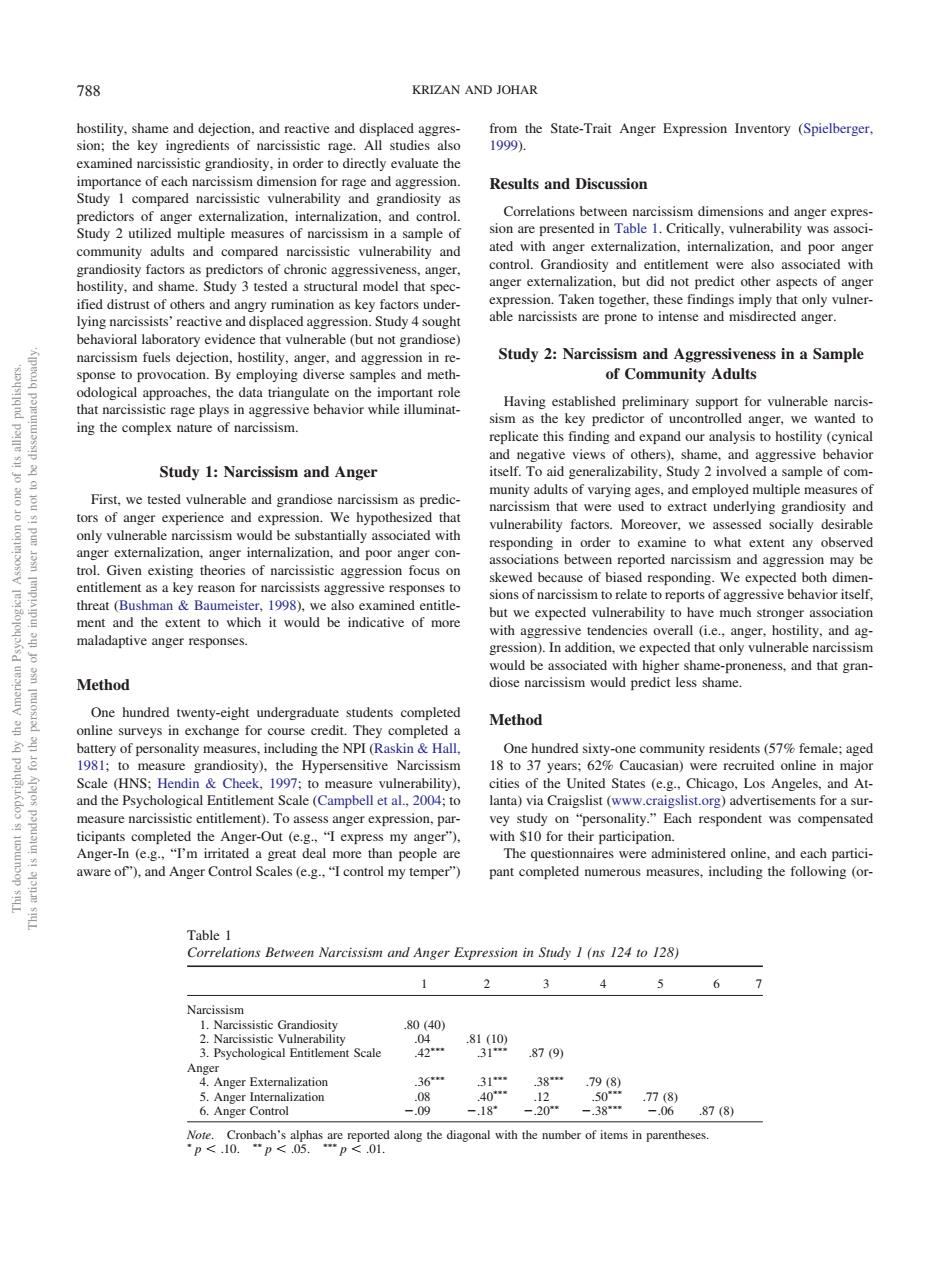正在加载图片...

788 ed agg SuT ng Expe y Siebrer ance of each on for ra Results and Discussion of ange an iosity factors as rs of chronic ag Gra y,an dy 3 te are prone to intense ted anger but not gran Study 2:Narcissism and Aggressiveness in a Sample of Community Adults Havi we wanted to ing the complex nature of narcissism. his finding an d our analysis to hostility Study 1:Narcissism and Anger e subst reported narci sism and ggression may b Given existing theories of narcissistie aggr focus or t as a k ed bcause of bias ed responding.We expect and towhich it would be indicative ofmore out weexpccted vunerability to havemuchst ou high shame-proneness,and that gran- Method One hundred eieht unders tudents Method online survevs in exch. N( nge for course credit.Th n&H scale (HNS:Hen cities of the United States (Chicago.Los Angeles and At De. sure narcissistie entitlement)to asse dy on penonmliny”Eachesponderwge icipants completed the Anger-Out (my anger" aware of")and Anger Control Scales (ee"I control my temner") nant completed numerous measures includine the followine for 2 6 80(40 nt Scale 0481079 79hostility, shame and dejection, and reactive and displaced aggression; the key ingredients of narcissistic rage. All studies also examined narcissistic grandiosity, in order to directly evaluate the importance of each narcissism dimension for rage and aggression. Study 1 compared narcissistic vulnerability and grandiosity as predictors of anger externalization, internalization, and control. Study 2 utilized multiple measures of narcissism in a sample of community adults and compared narcissistic vulnerability and grandiosity factors as predictors of chronic aggressiveness, anger, hostility, and shame. Study 3 tested a structural model that specified distrust of others and angry rumination as key factors underlying narcissists’ reactive and displaced aggression. Study 4 sought behavioral laboratory evidence that vulnerable (but not grandiose) narcissism fuels dejection, hostility, anger, and aggression in response to provocation. By employing diverse samples and methodological approaches, the data triangulate on the important role that narcissistic rage plays in aggressive behavior while illuminating the complex nature of narcissism. Study 1: Narcissism and Anger First, we tested vulnerable and grandiose narcissism as predictors of anger experience and expression. We hypothesized that only vulnerable narcissism would be substantially associated with anger externalization, anger internalization, and poor anger control. Given existing theories of narcissistic aggression focus on entitlement as a key reason for narcissists aggressive responses to threat (Bushman & Baumeister, 1998), we also examined entitlement and the extent to which it would be indicative of more maladaptive anger responses. Method One hundred twenty-eight undergraduate students completed online surveys in exchange for course credit. They completed a battery of personality measures, including the NPI (Raskin & Hall, 1981; to measure grandiosity), the Hypersensitive Narcissism Scale (HNS; Hendin & Cheek, 1997; to measure vulnerability), and the Psychological Entitlement Scale (Campbell et al., 2004; to measure narcissistic entitlement). To assess anger expression, participants completed the Anger-Out (e.g., “I express my anger”), Anger-In (e.g., “I’m irritated a great deal more than people are aware of”), and Anger Control Scales (e.g., “I control my temper”) from the State-Trait Anger Expression Inventory (Spielberger, 1999). Results and Discussion Correlations between narcissism dimensions and anger expression are presented in Table 1. Critically, vulnerability was associated with anger externalization, internalization, and poor anger control. Grandiosity and entitlement were also associated with anger externalization, but did not predict other aspects of anger expression. Taken together, these findings imply that only vulnerable narcissists are prone to intense and misdirected anger. Study 2: Narcissism and Aggressiveness in a Sample of Community Adults Having established preliminary support for vulnerable narcissism as the key predictor of uncontrolled anger, we wanted to replicate this finding and expand our analysis to hostility (cynical and negative views of others), shame, and aggressive behavior itself. To aid generalizability, Study 2 involved a sample of community adults of varying ages, and employed multiple measures of narcissism that were used to extract underlying grandiosity and vulnerability factors. Moreover, we assessed socially desirable responding in order to examine to what extent any observed associations between reported narcissism and aggression may be skewed because of biased responding. We expected both dimensions of narcissism to relate to reports of aggressive behavior itself, but we expected vulnerability to have much stronger association with aggressive tendencies overall (i.e., anger, hostility, and aggression). In addition, we expected that only vulnerable narcissism would be associated with higher shame-proneness, and that grandiose narcissism would predict less shame. Method One hundred sixty-one community residents (57% female; aged 18 to 37 years; 62% Caucasian) were recruited online in major cities of the United States (e.g., Chicago, Los Angeles, and Atlanta) via Craigslist (www.craigslist.org) advertisements for a survey study on “personality.” Each respondent was compensated with $10 for their participation. The questionnaires were administered online, and each participant completed numerous measures, including the following (orTable 1 Correlations Between Narcissism and Anger Expression in Study 1 (ns 124 to 128) 1 2 3 4 5 67 Narcissism 1. Narcissistic Grandiosity .80 (40) 2. Narcissistic Vulnerability .04 .81 (10) 3. Psychological Entitlement Scale .42 .31 .87 (9) Anger 4. Anger Externalization .36 .31 .38 .79 (8) 5. Anger Internalization .08 .40 .12 .50 .77 (8) 6. Anger Control .09 .18 .20 .38 .06 .87 (8) Note. Cronbach’s alphas are reported along the diagonal with the number of items in parentheses. p .10. p .05. p .01. This document is copyrighted by the American Psychological Association or one of its allied publishers. This article is intended solely for the personal use of the individual user and is not to be disseminated broadly. 788 KRIZAN AND JOHAR�����������������������������������������